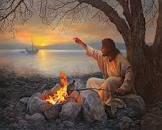
The last chapter of St John’s gospel would appear to be an addition, since chapter 20 seems to have been the original ending. It is possible that the author found more material to add or that he wanted to expand his resurrection narrative. It may be that someone else, close to John, added the chapter, with a story that was independent of the Jerusalem appearances. There is also a sense that the writer is revisiting the ministry of Jesus, to show more clearly the completeness of God’s plan.
It is noteworthy that the action of this story takes place in Galilee, unlike the other appearances in John. It is almost as though we are being taken back to the beginning, when the disciples were first called by Jesus as recounted in Luke 5:1-11. If John was familiar with that story, perhaps he decided to include it at this point. The breakfast Jesus cooked consisted of bread and fish, reminiscent of the feeding of the five thousand, and it can be seen as well as a Eucharistic meal.The charcoal fire recalls the fire on which Peter warmed his hands as he denied his master. Chapter 21 therefore is also very important in establishing that Peter has been given the opportunity to express his love for Jesus three times, and then to have his role as shepherd of his flock confirmed. Since the gospel of John is so different to the synoptics and does not emphasise his leadership in the way that they do, it might have been felt necessary to highlight this in the final words. By the time it was written, Peter would have glorified God by being crucified like his saviour.